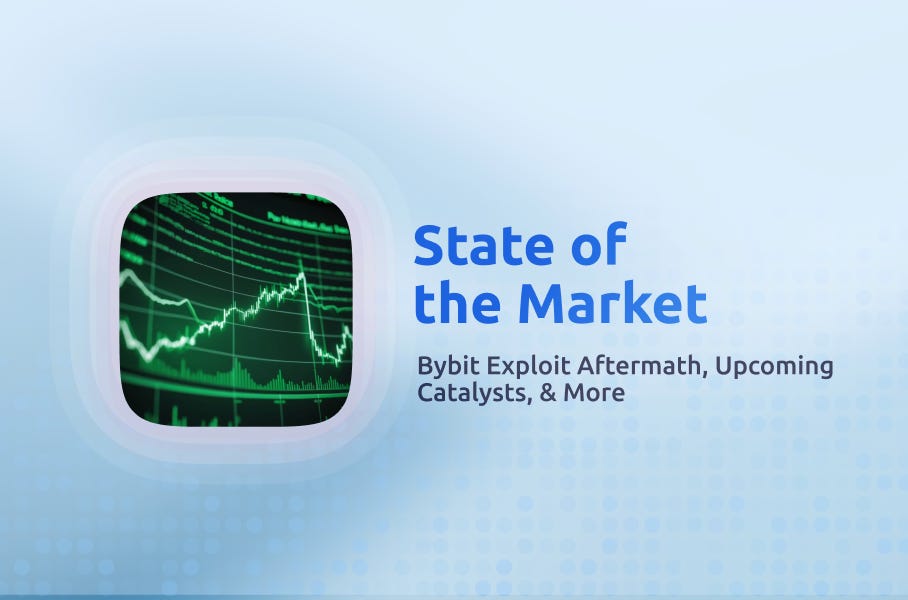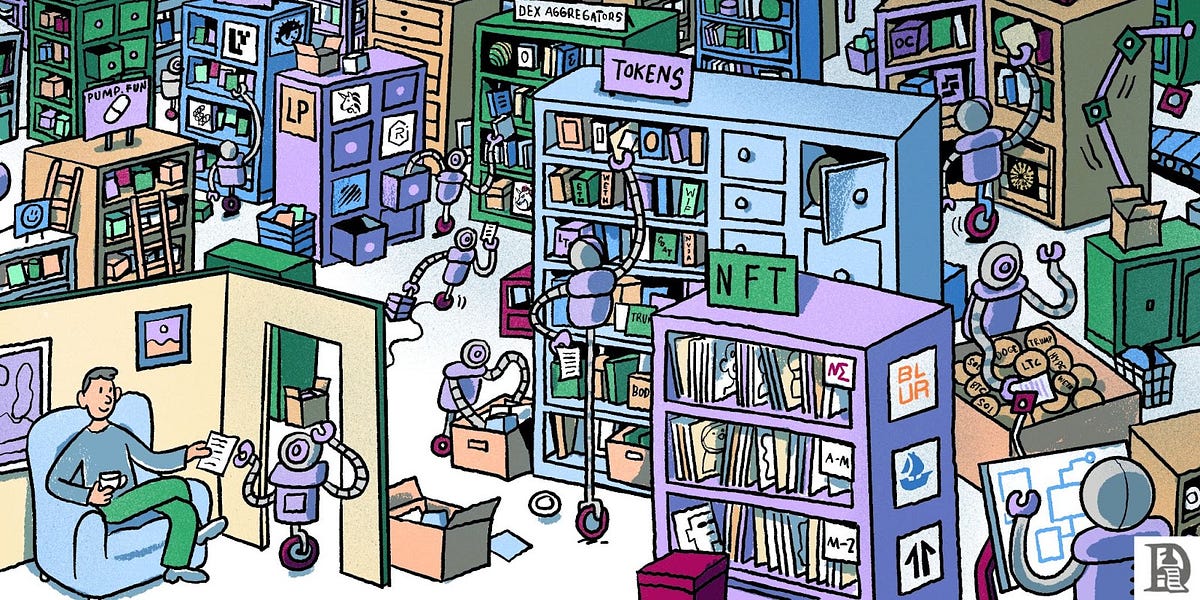- Web3 Investor Briefing by w3.group
- Posts
- Web3 Investor Briefing | Mar 2025
Web3 Investor Briefing | Mar 2025
Every month we provide you with insightful deep-dives into the world of Web3 investing.
Welcome to the second edition of our new investor briefing with the latest insights and strategic analysis from across the crypto landscape.
TL;DR
Macro analysis, market updates and a fundamental deep dive into Maple Finance with Julius from w3.wave, exploring how institutional lending is evolving despite market volatility.
Consumer crypto insights with Henrik from w3.ventures, examining the tokenization of social capital and how it's creating entirely new markets for creators and users.
The new BMF letter and its strategic implications for investors with Tom from w3.labs, providing critical insights for staking setups in Germany.
Let's dive into the latest developments in Web3, during a time of peak market uncertainty that stands in contrast to the increasingly robust fundamentals driving long-term value in the space.


As a long-time crypto investor, I’m no stranger to market volatility and shifting sentiment. Over the past two months, investor confidence has plummeted, with the “fear and greed index” hitting lows not seen since the FTX crisis in 2022.
Interestingly, this comes just as institutional adoption takes another step forward, marked by Donald Trump’s latest executive order on Bitcoin and crypto.

No crypto without macro
In our previous Newsletter we used the title “Macro Is King” to share our thoughts on the current dependency of crypto markets and external factors. Fast forward six weeks and this dependency has arguably only become stronger.
As such, we spend a lot of time digesting macro news and trying to filter through the noise to shape our probabilistic thinking of markets. This is also something I have written about on LinkedIn a couple of weeks ago:
Strategic Bitcoin Reserve (SBR) & market update
Even the highly anticipated news out of the White House was not able to support most token prices during this time of increased uncertainty in markets. The new US administration has officially announced the creation of a SBR, which, for now, will hold previously seized Bitcoins. While we do think that this is a net positive development in the mid-to long-term, it clearly did not meet investors’ expectations reflected in current price action.
Year to date, most altcoins are down over 70%, with many hitting new lows below last September’s bottom. Bitcoin has broken its range, now trading between the high $70Ks and low $80Ks, down ~15% YTD and ~25% from its January highs (as of March 17).
I gave an overview of the current developments and shared my thoughts on investing in crypto markets during these first months of a Donald Trump presidency in last week’s episode of the Finance Forward Podcast in German 🇩🇪 ).
Fundamental deep dive
Despite all the macro headlines and recent panic selling, let us not lose sight of some of the great fundamental developments, that excite us in the broader crypto space.
One such development is stablecoins (digital representations of fiat currencies e.g. USD, EUR) moved onto the blockchain. Today, stablecoins already capture 1% of the entire M2 money supply.

Source: Coinglass
Stablecoins are fast becoming the backbone of on-chain finance, driving demand for lending, borrowing, and swapping, and in turn funneling revenue into leading DeFi protocols. We believe this momentum will continue as the world recognizes the efficiency gains from on-chain assets, paving the way for more tokenized financial products and services.
This backdrop is precisely why we’re encouraged by protocols like Maple Finance, which continues to achieve milestones in the institutional lending space. Maple Finance has continued its growth in the institutional lending space, with active loans sitting at an all-time high, just shy of $260 million.

Source: Token Terminal
Most of Maple’s recent growth can be attributed to the launch of its “Syrup” product, which allows retail users to access attractive institutional lending yields via a simple and intuitive interface. We think that this is a great example of a DeFi protocol accelerating adoption and highlighting the possibilities of on-chain finance.

Source: syrup.fi

The next wave of consumer crypto represents a fundamental shift — from tokenizing financial assets and collectibles to creating markets for previously intangible social assets. By turning attention, time, and trust into measurable, tradable commodities, we're witnessing the creation of entirely new markets that rebalance the digital economy in favor of creators and users.
Today's digital economy suffers from fundamental imbalances. Platform algorithms prioritize engagement over quality, leaving users drowning in noise. Creators receive pennies on the dollar for their contributions while platforms capture most of the value. Trust remains elusive in increasingly anonymous online interactions, and sustainable business models beyond advertising remain scarce.
The tokenization of social capital directly addresses these challenges. By creating market mechanisms for previously intangible assets, we can build systems where quality rises above noise, creators capture their true value, and trust becomes a visible, tradable commodity.
Digital interactions that once generated value primarily for platforms are now becoming directly monetizable by users themselves. This transformation has a positive impact on both sides of the market:
For users:
Access higher-quality information through market-validated filtering mechanisms
Engage directly with value creators through access systems
Navigate digital relationships with greater confidence using transparent reputation data
For creators:
Capture a significantly larger portion of the value they generate
Price their contributions according to actual market value rather than platform dictates
Develop diverse, sustainable revenue streams independent of advertising or platform algorithms
Innovation in action: Leading examples
Quality discovery: Kaito
Kaito surfaces valuable insights from the vast daily volume of crypto tweets, saving users hours previously spent filtering through low-value content. Traders can more efficiently identify actionable insights without scrolling through thousands of tweets.

Trust markets: Ethos
Ethos reduces risk in digital transactions by turning reputation into a real-time market signal. Users can immediately see if someone is trusted by the community before engaging. Their browser extension displays reputation scores on platforms like X.

Access markets: time.fun
time.fun provides direct access to creators through a market-based system where creators receive 95% of redemption value. Users can get meetings, direct Q&A messages, and access to group chats with creators who would normally ignore DMs.

Mainstream potential
As social capital becomes liquid and programmable, we expect to see plenty of new consumer applications that leverage these primitives, extending far beyond crypto into mainstream industries. Here are just two of the many cases we can think of:
Knowledge economy: Consultants, educators, and experts can price their time based on market demand, and their reputation becomes a quantifiable, verifiable asset in hiring and collaboration. A great example would be a lawyer's consulting fee that transparently adjusts based on expertise/reputation and demand.
Media & community: Content discovery can be driven by stake-based curation rather than engagement algorithms, allowing communities to operate with transparent value signals. News sources will develop reputation scores that reflect accuracy over time.
Conclusion
Projects like Kaito, time.fun, and Ethos are pioneering this approach today, laying the groundwork to improve people's digital lives – not with ideological promises, but with practical products that were not possible before. This represents an evolution in consumer crypto that transforms how we measure, exchange, and capture value in digital spaces.

The infographic shows the amount of funding rounds and total investment volume over the last 30 days.

Staking taxation in Germany: Strategic implications for investors
The German Federal Ministry of Finance's March 2025 letter has finally clarified many aspect around the tax treatment of cryptocurrency staking activities, creating both challenges and opportunities for investors. The distinction between active and passive staking now has significant financial implications.
Understanding the guidelines
Under the clear guidelines, passive staking—where you delegate your assets to validators without direct involvement in block creation—is classified as "other income" under §22 No. 3 of the Income Tax Act. This supports the one-year holding period rule for staked assets, allowing crypto assets held for more than a year to be sold tax-free, regardless of gains.
In contrast, active staking—operating as a validator yourself—risks the operators activities being classified as commercial. This classification comes with many implications around holding periods, documentation requirements, trade taxes, and VAT.
Next steps for crypto investors
Smart investors are now restructuring their staking activities to maintain their classification while still participating in network validation. This includes considering delegation services and maintaining clear documentation that staking is primarily for asset management rather than business purposes.
Checklist:
Review current staking arrangements in light of the guidelines
Document all transactions meticulously, including staking rewards
Check current activities for potential commercial classification
Explore solutions like w3.labs' to minimize effort and maximize rewards
The w3.labs innovation
Our team at w3.labs has developed a solution that directly addresses many challenges under the guidelines. Our smart contract-based Ethereum staking system allows stakers to operate under full self-custody while qualifying as passive stakers under the guidelines. The system creates a delegation relationship between the staker and our consensus services, effectively preserving the advantages of passive staking while providing the technical benefits of native Ethereum validation.
For investors, this is an important distinction, representing significant savings in capital cost and effort and effectively boosting the staking rewards.
While the regulatory landscape continues to evolve, the guidelines provide additional clarity. With proper planning, German crypto investors can navigate these changes effectively. Contact our team at w3.labs now to learn more about our staking solution.
This newsletter segment provides general information and should not be considered tax advice. Individual circumstances vary – consult a qualified tax professional before making financial decisions.
We are live on Solana & Celestia
In addition to Ethereum, w3.labs plans to launch many more chains, and we are pleased to announce that we have started with Celestia and Solana.
The entire w3.group is very close to the teams behind Celestia and Solana, making them our first choice for providing our validation services. While you should definitely check out our staking platform via the button at the bottom of this newsletter, here are the direct links to our validators on both chains: Solana Validator | Celestia Validator

This chart shows the growth of transactions on Ethereum Layer 2 chains like Base, proving Ethereum's approach to scaling and the demand for Ethereum blockspace.












